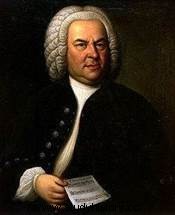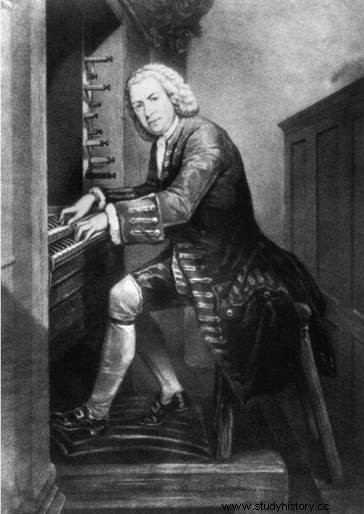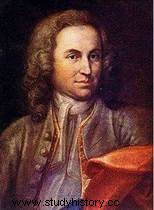 Joan Sebastian Bach (1685-1750) is a German music composer of the Baroque period , who wrote hundreds of pieces for organ, harpsichord and orchestra, concertos, masses, cantatas, etc... His work constitutes a decisive stage in the evolution of classical music:he developed a sort of “musical grammar” (the “Bach grammar”, in particular based on the superposition of several melodic lines) used to achieve the perfect musical form. Bach's music as a whole goes far beyond the synthesis of stylistic tendencies of Baroque music:indeed it has a universal value for all modern Western music.
Joan Sebastian Bach (1685-1750) is a German music composer of the Baroque period , who wrote hundreds of pieces for organ, harpsichord and orchestra, concertos, masses, cantatas, etc... His work constitutes a decisive stage in the evolution of classical music:he developed a sort of “musical grammar” (the “Bach grammar”, in particular based on the superposition of several melodic lines) used to achieve the perfect musical form. Bach's music as a whole goes far beyond the synthesis of stylistic tendencies of Baroque music:indeed it has a universal value for all modern Western music.
The youth of Johann Sebastian Bach
Coming from an exceptional family of German musicians from the 15th century until 1840, Jean-Sébastien Bach is considered one of the greatest geniuses of all time. Born March 21, 1685 in Eisenach, he was the youngest of a family of eight children. His father Ambrosius Bach introduced him to the violin very early. While still very young, he lost his parents and it was his older brother Johan Christophe Bach, organist of Ohrdruf, who acted as his father and taught him the organ.
 At the age of fifteen, after passing his exams at the Ohrdruf boarding school, young Johann Sebastian Bach returns to Lüneburg where he acquires a complete education. He is passionate about Latin and theology. It was at the court of Celle that he learned some rudiments of French, the language of the European aristocracy, the music being conducted by Frenchmen. At the church of St Michel de Lunebourg he discovered polyphonic vocal music. He met in Hamburg the best artists of his time, in particular Rieken.
At the age of fifteen, after passing his exams at the Ohrdruf boarding school, young Johann Sebastian Bach returns to Lüneburg where he acquires a complete education. He is passionate about Latin and theology. It was at the court of Celle that he learned some rudiments of French, the language of the European aristocracy, the music being conducted by Frenchmen. At the church of St Michel de Lunebourg he discovered polyphonic vocal music. He met in Hamburg the best artists of his time, in particular Rieken.
Prince of Baroque music
Appointed successively as organist at Armstadt in 1703 and then at Mulhausen in 1707, he will amaze with his musical virtuosity. That same year he married, at the age of twenty-two, his distant cousin Maria Barbara Bach, with whom he had seven children. He rose to the post of choirmaster at the court of the Duke of Saxe-Weimar, then to that of director of the Duke's concerts. From 1714 to 1723 he again held the position of choirmaster, but this time at the court of the Prince of Analt-Goeten.
When he returns, sad news awaits him:the death of his wife. Eighteen months later, he remarried the singer Anna Magdalena Wilcken with whom he would have another fourteen children. In 1723 Bach sought the succession of Kuhnau as Cantor at St Thomas in Leipzig, which was a very honorary title, and also directed the collegium Musicum, a musical society founded by Téléman, official musician of the court of Saxony.
Bach will have a famous encounter in 1744 in the person of Frederick II during which he will improvise a fugue in four voices, on a theme proposed by the royal flautist.
Despite a few oil portraits, the face of the great musician remains enigmatic. All his life he will work in difficult conditions, tested by the loss of eleven of his children and will be blind for the last three years of his existence. With extreme simplicity and great modesty he will affirm:"I worked diligently, whoever applies himself as well as me will do the same"
"Work for God" is his motto as a Christian, a mystic, and in all his works we find not only the builder of genius but also the poet and the believer. Johann Sebastian Bach died of a stroke on July 28, 1750, aged sixty-five. Four of his sons (Wilhelm Friedemann, Carl Philip Emanuel, Johann Christoph Friedrich and Johann Christian) will also be recognized composers.
The priceless musical legacy of Johann Sebastian Bach
His many vocal, secular and religious works alone would be enough to sum up all his art. If all the forms are represented there, cantatas, motets, oratorios, passions, masses, the chorale and the fugue dominate. The melody and the air and the air alternate with the recitative and the chorus, while the Latin words (magnificat, masses) have less importance than the German texts (cantatas, passions). He also endeavored to transcribe his religious faith (he was Protestant) into music; each note and each chord being the musical symbol of a religious idea or image.
Composed in Liepzig in 1733, the Mass in B minor is one of the peaks of Bach's vocal production thanks to its breadth, its brilliance, the ardor of its religious inspiration. (It was given in many concert halls at the end of the Second World War, which is to say its true healing power on souls).
Organist and harpsichordist, his two favorite instruments, are endowed with a literature never equaled by the quality and quantity of his works, but he does not disdain string instruments and wind instruments (violin, cello, flute), nor orchestral music.
Bach's multiple works synthesize the resources of polyphony and harmony:chorales, preludes, fugues, concertos, quartets, suites, sonatas, constitute the solid framework supporting the edifice of the entire work (of which some biographers nevertheless believe that a large part has been lost).
 If the composer, who writes mainly for the church and the princely courts hardly innovates in terms of form , he gives each of them a perfection signed by his profound genius. For him, greatness consists in “speaking the language of all”. An admirable synthesis of two centuries of constant effort, its innovative message in the field of rhythm and harmony looks to the future.
If the composer, who writes mainly for the church and the princely courts hardly innovates in terms of form , he gives each of them a perfection signed by his profound genius. For him, greatness consists in “speaking the language of all”. An admirable synthesis of two centuries of constant effort, its innovative message in the field of rhythm and harmony looks to the future.
This great musical architect, this sculptor, this painter, this poet could be compared to the creator of the Medici tomb, of the ceiling of the Sistine Chapel and of so many summits:Michel- Angel. But in the vocal and instrumental creation of Johann Sebastian Bach it is the man of faith who speaks, the believer who rises and the mystic who exalts himself.
''Music owes to Johann Sebastian Bach as much as a religion to its founder.'' Robert Schuman.
Some works
- The Brandenburg Concertos
- St John's Passion
- Mass in B Minor
- Passacaglia and Fugue for Organ in C minor
- Toccata and Fugue in D minor (organ)
- Passion according to St Mathieu
- The Art of Running Away
To go further
- Bach in his time, by Gilles Cantagrel. Fayard, 1997.
- Johann Sebastian Bach, biography of Roland de Candé. Threshold, 2000.
